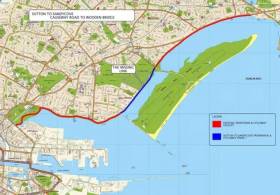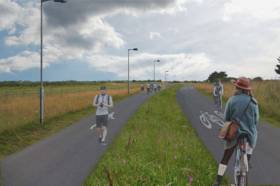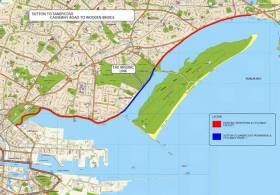Displaying items by tag: S2S
Dun Laoghaire-Rathdown Councillor Barry Ward will be among the speakers at a public meeting in Dun Laoghaire later this month on the S2S (Sutton to Sandycove) coastal promenade and cycleway around Dublin Bay.
Long in the development stages, the S2S has been beset by planning snags and funding issues, and as yet only sections on the northern side of Dublin Bay between Sutton and Clontarf have been completed.
Michael Collins (S2S) and Clara Clark (Cycling Without Age) will also address the meeting at the Royal Marine Hotel on Tuesday 22 October from 7.30pm to discuss current and future moves on the project, including the €17.5 million allocated earlier this year for the section from Merrion Gates to Dun Laoghaire Harbour.
All are welcome to attend.
Approval For Coastal Cycle Path In North Dublin
#Coastal - Planning permission has been granted for a new coastal cycle and walking path between Baldoyle and Portmarnock, as The Irish Times reports.
The new 1.8km path, which has much local support, will take cyclists off a narrow country road running between the two North Dublin suburbs.
It will also be in close proximity to the Sutton–Clontarf section of the S2S cycle route, and may be extended to both Sutton and Malahide in future.
The Irish Times has more on the story HERE.
Clontarf Section Of Dublin Bay Cycleway To Open March
#S2S - The latest section of the Sutton to Sandycove (S2S) cycle route around Dublin Bay will not be opened till March due to delays on water main works, as Irish Cycle reports.
Once completed, the new cycle track — with mixed pedestrian and cyclist sections at junctions — will connect the pre-existing tracks between Sutton and the Bull Island causeway, and the route from Bull Bridge to East Wall Road.
As yet no section of the southside portion of the S2S has been completed, though a public consultation on the corridor from Sandymount/Merrion to Blackrock is currently open for public consultation till 31 January.
Irish Cycle has more on the story HERE.
Independent Report Backs Reduction Of Clontarf Sea Wall Height
#DublinBay - An independent expert commissioned to evaluate local concerns over the new sea wall in Clontarf has recommended its height be reduced by at least 10 centimetres.
As previously reported on Afloat.ie, fears had grown among residents in the North Dublin Bay suburb that new flood defences constructed as part of the Sutton to Sandycove cycleway would exceed the height of the existing wall at the wooden bridge to the Bull Wall.
In response, Dublin City Council commissioned Dr Jimmy Murphy of University College Cork to examine the "technical information" that directed construction plans which residents claim breach previous promises over its maximum height and appearance.
But according to The Irish Times, while Dr Murphy's draft report says the wall's 4.25m height was "appropriate" in light of the council's long-term flood prevention criteria, there was no consistency as to the design plans and information used to inform such.
And for the time being, Dr Murphy suggests reducing the wall's "sea level rise" allowance by 10 to 20cm "at locations where the visual amenity is most affected".
The Irish Times has much more on the story HERE.





























































